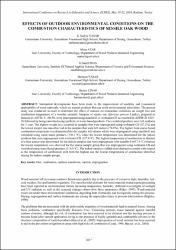| dc.contributor.author | Yaşar, Şekip Şadiye | |
| dc.contributor.author | Atar, Musa | |
| dc.contributor.author | Fidan, Muhammed Said | |
| dc.contributor.author | Yaşar, Mehmet | |
| dc.contributor.author | Çınar, Hamza | |
| dc.date.accessioned | 2019-12-13T07:43:13Z | |
| dc.date.available | 2019-12-13T07:43:13Z | |
| dc.date.issued | 2016 | |
| dc.identifier.uri | https://hdl.handle.net/20.500.12440/1591 | |
| dc.description.abstract | Substantial developments have been made in the improvement of usability and economical applicability of wood materials, which are natural products that can resist environmental adversities. The present study was conducted in order to determine the effect of outdoor environmental conditions on weight loss and combustion temperature of a wooden material. Samples of sessile oak (Quercus petreae Lipsky), prepared as dictated in ASTM–E 160-50, were impregnated using tanalith-E or wolmanit-CB as reported in ASTM–D 1413–76 followed by being varnished using synthetic or water-based products. The varnished products were left outdoors for 1 year. The highest weight loss occurred in samples that were impregnated using wolmanit-CB (87.2%) and the lowest weight loss was observed in the samples that were left indoors (74.6%). The highest heat source based combustion temperature was determined for the samples left indoors which were impregnated using tanalith-E and varnished using water-based products (530.1 oC), while the lowest temperature was determined for the indoor products that were impregnated with wolmanit-CB (427.4 oC). The highest temperature of combustion in absence of a heat source was determined for the indoor samples that were impregnated with tanalith-E (637.4 oC) whereas the lowest temperature was observed for the indoor sample group that was impregnated using wolmanit-CB and varnished using water-based products (516.9 oC). The indoor samples yielded more distinctive results with respect to the temperature of combustion with both the highest and the lowest temperatures of combustion identified among the indoor sample groups. | en_US |
| dc.language.iso | eng | en_US |
| dc.publisher | International Conference On Research In Education & Science (ICRES2016) | en_US |
| dc.relation.ispartofseries | Proceeding Book; | |
| dc.relation.ispartofseries | ;1037-1047 | |
| dc.rights | Attribution 3.0 United States | * |
| dc.rights | info:eu-repo/semantics/openAccess | en_US |
| dc.rights.uri | http://creativecommons.org/licenses/by/3.0/us/ | * |
| dc.subject | oak | en_US |
| dc.subject | Combustion | en_US |
| dc.subject | Outdoor conditions | en_US |
| dc.subject | Varnish | en_US |
| dc.subject | Impregnation | en_US |
| dc.title | EFFECTS OF OUTDOOR ENVIRONMENTAL CONDITIONS ON THE COMBUSTION CHARACTERISTICS OF SESSILE OAK WOOD | en_US |
| dc.type | article | en_US |
| dc.relation.publicationcategory | Makale - Uluslararası Hakemli Dergi - Kurum Öğretim Elemanı | en_US |
| dc.description.scopuspublicationid | 57073017800 | en_US |
| dc.department | [Belirlenecek] | en_US |
| dc.contributor.institutionauthor | [Belirlenecek] | |




















